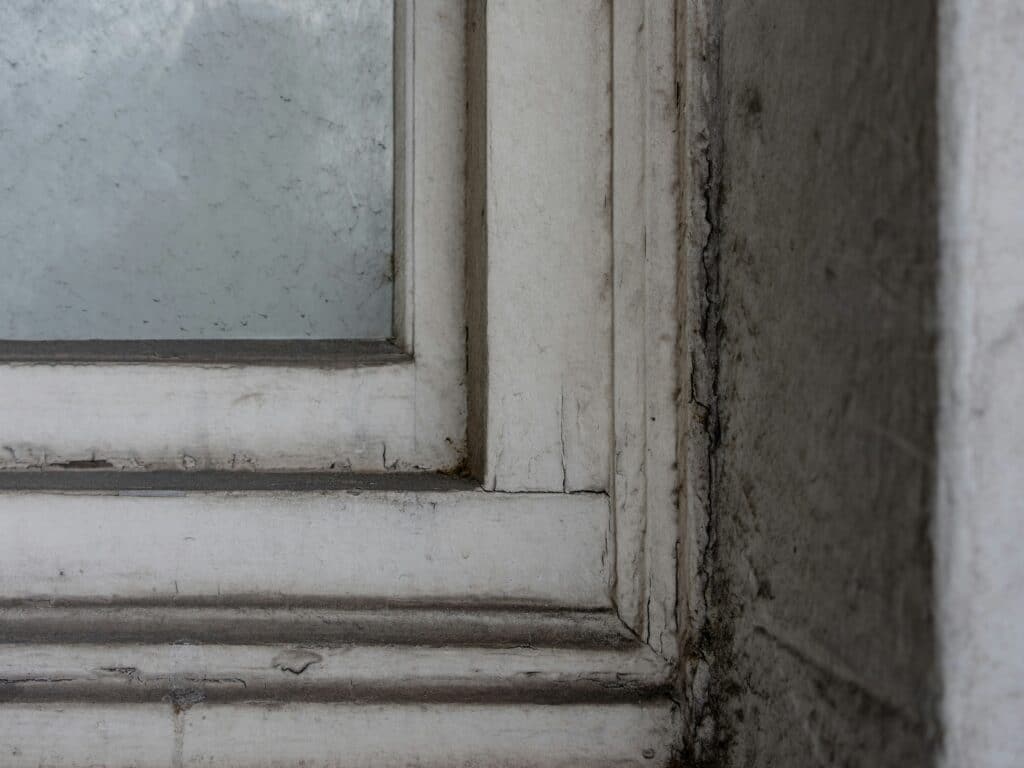
Neglecting your window sills and tracks can cause more significant problems than just dust and grime. Dirt accumulates in these neglected crevices, preventing windows from closing properly and potentially damaging your window hardware.
In short, those slim ledges deserve more attention than they often receive.
In this blog post, we’ll cover everything from gathering the right tools to tackling stubborn grime to sealing and maintaining your window sills and tracks.
Let’s get started.
Materials Needed to Clean Window Sills and Window Tracks
Before you can start cleaning, make sure you have everything you’ll need:
The tools and supplies you should have are:
- Microfiber cloths and paper towels. You’ll need one for wet cleaning, another for drying/polishing
- Vacuum cleaner with crevice tool. You will need this for removing loose dust and debris (or a handheld shop vac)
- Soft‑bristle brush or old toothbrush. This is good for scrubbing corners and getting into narrow grooves
- Putty knife or plastic scraper to lift hardened gunk or paint drips
- Cotton swabs or foam paintbrushes for fiddly, tight spots
- Rubber gloves to protect your hands from chemicals and grime
- Bucket or spray bottles to hold cleaning solutions
The cleaning solutions that you’ll be needing are:
- Warm water + mild dish soap. This is a gentle option for daily, clean-level dirt
- White vinegar + water (1:1). Natural, very effective in cutting grease and mineral buildup
- All‑purpose cleaner for tougher dirt, pet stains, and adhesive residue
- Baking soda. Combine with vinegar to create a foaming paste that lifts stubborn grime
- Rubbing alcohol or window cleaner: This is for final detailing and shine
Protection and preparation items needed are:
- Masking tape or painter’s tape: Optional, to seal off areas you’re not cleaning or protect painted surfaces
- Plastic drop cloth or towel: To preserve the sill and surrounding surfaces from drips
Optional Extras (Deep Cleaning)
- Compressed air canister: Ideal for blowing out dust from extremely tight grooves
- Silicone lubricant / Teflon spray: A finishing touch for sliding tracks to ensure smooth operation
- White vinegar-soaked cloth: Lay across mineral deposits for 30‑60 minutes to dissolve them.
Next is a breakdown of the most effective way to clean your window sills and tracks.
How to Clean Window Sills
Here’s how to clean your window sills:
1. Clear and Vacuum First
- Remove any items like potted plants, decorations, and dust catchers from the sill
- Vacuum loose debris using the crevice attachment. Focus on corners and along the front edge where dust accumulates
2. Dust and Scrub
- Dry‑brush the entire surface with a soft brush or old toothbrush to dislodge crusted dirt
- Check paint or wood integrity. If paint is peeling, gently scrape just enough loose material to smooth the surface
3. Apply Cleaning Solution
- For general dust/oil residue, mix warm water + dish soap
- For heavier mineral stains (e.g., near AC units or humid climates), apply a vinegar solution or sprinkle a little baking soda, then spray with vinegar
- For tough spots, use an all‑purpose cleaner
- Let the solution sit for 2–3 minutes, as this helps to soften the grime
4. Scrub and Detail
- Use the toothbrush to scrub in tight corners and grooves
- Gently remove hardened materials like old caulk, paint drips, or adhesive buildup with a plastic scraper
- Clean along weatherstrips or complex areas with cotton swabs or a paintbrush
5. Wipe Clean and Dry
- Wipe with a microfiber cloth dampened in clean water to remove residue
- Follow with a dry cloth or paper towel. This is especially important for wood surfaces to prevent water damage
6. Optional: Protect and Seal
- For painted or wood sills, consider applying a thin coat of clear sealant or wax to repel future dust and moisture
- For vinyl or composite surfaces, a quick wipe with a microfiber cloth is usually sufficient
How to Clean Window Tracks
Window tracks accumulate the worst grime. Think dirt, dead insects, leftover paint, grease, and weather-deposited residues.
Here’s how to thoroughly clean your window tracks:
1. Preparation and Dry Cleaning
- Open the window fully for full access
- Vacuum first with a crevice tool attachment. Remove loose debris, dried leaves, and crumbs
- Compressed air (optional): Blow out stubborn dust and sand that the vacuum can’t reach
2. Apply Cleaning Mixture
- Create a potent mix of warm water + dish soap, or vinegar solution for mineral/adhered residues
- Drench the track thoroughly without soaking the surrounding floor. Lay down a drop cloth if needed
- Let it soak for 5–10 minutes. This softens grime and dissolves adhesives or dried sap
3. Scrub and Scrape
- Use a toothbrush to scrub the dirt, especially in corners and bolt holes
- Gently pry away sticky buildup with a Plastic putty knife or scraper. Be careful not to gouge metal or vinyl
- For extreme buildup, sprinkle baking soda, spray vinegar again, let it foam, and then scrub
4. Rinse and Remove Residue
- Wipe with plenty of clean, damp microfiber cloths
- For larger windows, rinse the cloth in a clean bucket of water repeatedly
- Ensure absolutely no cleaner residue is left, especially within weep holes (small drainage exits in many window systems)
5. Dry and Lubricate
- Dry thoroughly with a clean towel, as wet tracks can trap new dust quickly
- Apply a silicone-based lubricant or Teflon spray along the track,s as this helps windows slide smoothly and resists future dirt buildup (Optional)
Conclusion
Tackling dirty windowsills and grime-filled window tracks might seem like a daunting task, but as this guide demonstrates, with the right materials and a systematic approach, your window sills and tracks can look brand-new and operate smoothly.
The effort invested will be immediately evident in brighter, cleaner windows that not only enhance your home’s aesthetics but also contribute to a healthier indoor environment by reducing accumulated dust and allergens.
If you’re seeking a clean home without the hassle, let Clear View Services provide you with professional cleaning services in Kent and the surrounding area.
Reclaim your time and enjoy the benefits of a truly clean space today.
Frequently Asked Questions (FAQs)
1. How often should I clean my window sills and tracks?
For most households, cleaning your window sills and tracks once every 3 to 4 months is sufficient. However, if you live in a high-traffic area, near a construction zone, or in a humid or dusty environment, you may want to clean them monthly to prevent buildup and mold.
2. Are vinegar-based cleaners safe to use on all window materials?
Vinegar solutions are safe for most materials, including vinyl, aluminum, and painted wood. However, if your window sills or surrounding surfaces are made of natural stone like marble or slate, avoid using vinegar regularly as it can etch or dull the finish over time.
3. Do I need to remove the window completely to clean the tracks thoroughly?
Not usually. Most standard windows can be cleaned in place without removing them. If the window is already off-track or you’re doing a deep maintenance clean, removing it may give you better access but it’s not required for routine cleaning.
4. Can I use bleach to clean mold on my window sills or tracks?
Yes, you can use a diluted bleach solution (one part bleach to ten parts water) to treat mold and mildew. Apply the solution, let it sit for 5 minutes, then scrub and rinse thoroughly. Be cautious when using bleach on untreated wood, as it can discolor or damage the surface unless sealed properly afterward.
5. How much pressure should I use with a scraper on tough grime or paint drips?
Use light to moderate pressure. It’s better to make several gentle passes rather than scraping forcefully in one go. This approach helps prevent scratching or damaging the surface underneath.
6. Can I apply silicone lubricant to the tracks before rinsing them clean?
No, always wait until the tracks are completely cleaned and dried before applying silicone or Teflon spray. Lubricants adhere better to dry, residue-free surfaces and will function more effectively.
7. Will cleaning damage the insulation or weather stripping around my windows?
As long as you use soft brushes and avoid scraping directly against the seals, your insulation and weather stripping should remain intact. Use a gentle touch around these sensitive areas and avoid harsh chemicals that may break down rubber or foam components.
8. Is it okay to seal wooden window sills after cleaning?
Yes. Sealing wood sills is a smart way to prevent moisture damage and future grime buildup. Make sure the sill is completely dry, then apply a clear water-based polyurethane or sealant. This adds a protective layer and enhances durability.
9. How should I clean sliding glass door tracks, any different from windows?
The method is essentially the same. Begin with a thorough vacuum, soak with a cleaning solution, scrub with a brush, rinse and dry, then apply a lubricant to the track. Sliding door tracks may require additional attention due to their larger size or heavier hardware. If the rollers are accessible, you can clean or lubricate them separately for smoother operation.
